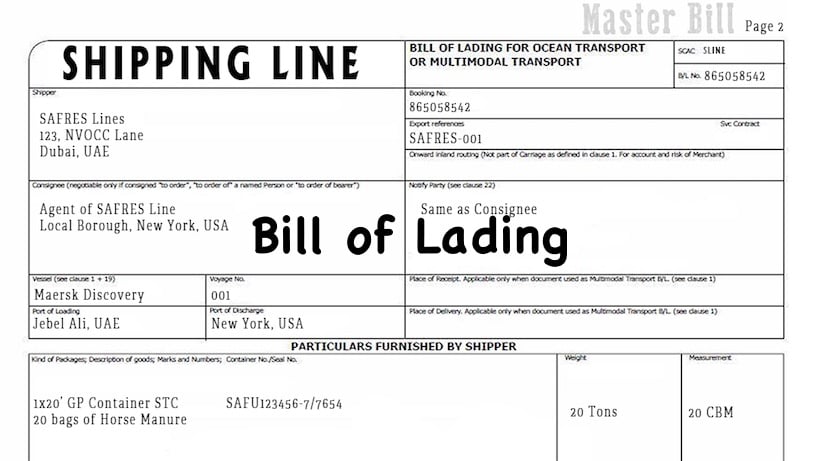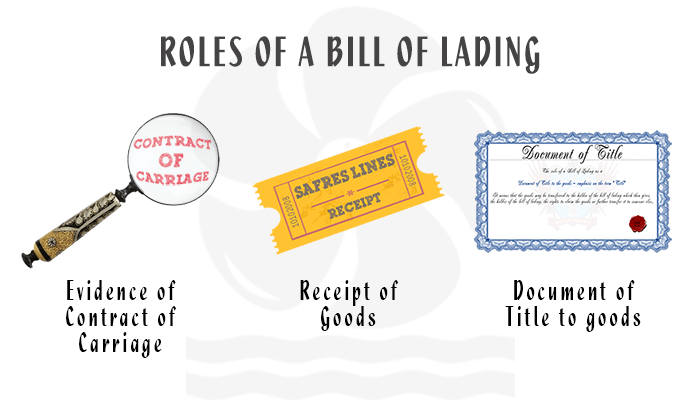
Table of contents
- what is Bill of Lading?
- Role of Bills of Lading in International Trade
- Key features of Bills of Lading.
- Is the Bill of Lading a contract or commercial document?
- What is document of title?
- Shipped Bill of Lading
- straight bill of lading
- ” To Order” Bill of Lading
- Multimodal Bill of Lading
- Combined Transport Document;
- Signing of Bills of Lading
- Bill of Lading & Master’s Role
what is Bill of Lading & Role of Bill of Lading in International Trade
Bills of Lading is a legal document which was developed to resolve the obvious conflict between the interests of the buyer and seller, and to provide, adequate security for the bank in International Trade.
The term “lade”(to load) means to load the cargo onto a ship or other form of goods carrier.

What is document of title?
• The Bill of Lading provides the seller with some security against default by the buyer provides the buyer with assurance that the seller has performed before he is required to make payment.
• The delivery of the goods can be made only against the presentation of an original bill of lading, it follows that transfer of the document can also transfer the right to take possession of the goods on discharge.
• It is for this reason is called the document of tittle.
Bills of Lading
• The seller can demand payment against the Bill of Lading and if not paid, he can (in theory at least) retain the Bill of Lading and hence has the right to collect the goods at discharge, or alternatively use the bill of lading to the goods to another buyer.
• The seller therefore shall retain the property in the goods as security against non-payment, so that if the buyer went into liquidation, they would not form part of the buyer’s general assets.

Key features of Bills of Lading.
Bill of Lading fulfills three roles.
• 1. It is a Contract. The shipping company agrees with the shipper—either the exporter or the importer, depending on the Terms of Trade (or Incoterms), to transport the merchandise from one port to another for a given amount of money; it is a contract of carriage.
• 2. It is a Receipt for the Goods. When the shipping company signs the bill of lading, it is acknowledging that it has received the goods in good condition and that everything seems in proper order. The document acts as a receipt for the goods; the shipping company accepts responsibility for the goods until their port of destination.
2.a. In some cases, the shipping company finds that something is “wrong” with the merchandise it is picking up (for example, the drums in which the merchandise is contained are rusty, or there are some damaged crates, or the merchandise was loaded when it was raining, or the merchandise was packaged in crates that are too weak to sustain an ocean voyage) and it does not want to assume responsibility for that condition. In those cases, the shipping company will make a note about the issue or write an exception on the bill of lading of what it has observed. The bill of lading then becomes a soiled bill of lading or a foul bill of lading.
2.b. In the opposite situation (i.e., when the shipping company finds everything in proper order at the time of loading and does not record any reservations at the receipt of the goods), the bill of lading is considered clean. In general, Letters of Credit and Documentary Collection transactions require a clean bill of lading should the bill of lading be soiled, it would require an amendment to the Letter of Credit. Carriers may not accept goods for transportation if loading them would result in a soiled bill of lading.
• 3. It is a Certificate of Title. The document that the shipping company will need to see to authorize the release of the goods in the port of destination will also be the bill of lading. It is commonly considered that the company who has the original of the bill of lading is the one to which the goods belong, or that the bill of lading is a Certificate of Title.
Shipped Bills of Lading and risks associated with it in respect to various stake holders.
Shipped Bill of Lading.
• The Shipped Bill of Lading provides evidence that the seller has performed his side of the bargain.
• The buyer can inspect the bill of lading before payment is made for the goods, inspection of the document providing the necessary assurance that the seller has performed.
• Thus a clean bill of lading provides the best indication of condition on shipment that is possible in practice.
• Shipped Bill of Lading; (Advantages)
• 1. It provides evidence that that seller has performed his contractual obligation. Evidence of Shipped Bill as required by FOB and CIF against received for shipment.
• 2.Document of title
• 3. Transfer of a document of title may also operate to transfer the property in goods.
• Shipped Bills of Lading; (Disadvantages)
• It’s a document of title, a carrier is taking an enormous risk in delivering without production of an original bill of lading: if he delivers to someone who is not entitled to the cargo, he is liable to the true owner of the full value of the cargo wrongly delivered.
Types of Bills of Lading:
• There are two types of bills of lading in this respect; the straight bill of lading is one on which the name of the consignee (the person or company who will pick up the goods at the port of destination) is specified.
• The’’ to order’’ bill of lading is one in which the name of the consignee is left blank or the term “to order” is written. This means that the bill of lading is negotiable bill of lading; in other words, it allows the sale of the cargo while it is at sea.
” To Order” Bill of Lading
• This is a common occurrence in certain industries, notably in the oil business, in which it is not unusual to see a specific cargo change hands several times during a given voyage.
• In some cases, the cargo is sold to a company that wants the cargo delivered in a different port, and the shipping company is asked to arrange for that alternative.
Multimodal Bill of Lading
• The multimodal bill of lading is a fairly recent document that has emerged because of the substantial increase in the number of international shipments in which the exporter delivers the goods to a carrier who will arrange for the transportation and delivery of the shipment until its final destination. Because the shipment is likely to take more than one mode of transportation, it is called an “multi modal shipment.” Multi Modal bills of lading, therefore, cover several legs of an international shipment.
• Multimodal bills of lading, therefore, cover several legs of an international shipment. They are straight bills of lading in the majority of cases. Multi Modal bills of lading are also receipts for the goods and evidence of a contract of carriage between the shipper and the carrier.
Combined Transport Document.
• Typically, the shipper will consign the goods to a forwarding agent at a collection depot inland.
• The Forwarding agent usually arranges the entire operation, there is likely to be more than one actual carrier and different carriers will be usually responsible for each section of the combined transport operation.
• Combined transport documents can be either negotiable or non-negotiable.
• Because the combined transport documents can be issued earlier than the traditional bill of lading before the goods are shipped, a negotiable document can in theory in appropriate kinds of transaction, help to resolve the problem of the vessel arriving before the documents can catch up.
Combined Transport Document; Disadvantages
Unlikely to provide security equivalent to the shipped bill of lading.
• 1. Issued before the shipment and hence not a shipped bill but a received B/L
• 2. Different international conventions may govern each part of the operation so that carrier’s liability varies depending on where damage to the cargo occurs.
Combined Transport Document; Advantages
• The essence of the combined transport document is that one carrier usually the forwarding agent, makes himself responsible for the entire operation.
• He may subcontract each stage or more commonly each stage after the initial land leg, but he contracts with the shipper as principal.
• He is liable to shipper and if the goods are damaged on any of the three stages, he will be sued for damage caused.
• However, the forwarding agent will be able to recoup his from another carrier.
• The single contracting carrier often referred to as a Combined Transport Operator. (C.T.O)
• Combined Transport document may be issued by a N.V.O.C. (Non vessel operating carrier) such as freight forwarder.
Signing of Bills of Lading
• When Master signs the B/L, the Master does so, not on behalf of the Charterers or Shippers, but on behalf of the Owners.
• The B/L is an Owner’s document, and it is the master’s responsibility to ensure to the best of his ability that it is properly prepared and signed. This applies whether the ship is employed on a Voyage or Time Charter.
Information on Bill of Lading
• Accurate information:
• If the B/L contains inaccurate or misleading statements about the quality or quantity of the cargo it covers, then Owners will be liable for the consequences, at least in the first instance. The master’s main concern must be, to see that this cannot happen.
Remarks on Bills of Lading
• Therefore, it is essential that the Master clauses directly on the bills the correct condition of the quality and quantity of cargo if these two items have not been properly described in the document presented to him for signing.
• If he wants assistance with the wording to be used in the clausing, he should call the commercial office who may engage the local P & I representative for advice.
Action in case of incorrect B/L
• If an incorrect B/L is issued, for whatever reason, the situation is not necessarily wholly beyond repair, but speed of action is essential, since once a third party takes up the B/L relying on what is says, it is too late to make any correction. The Master must therefore notify the Owners and Charterers immediately of any apparent irregularity in any B/L which he has issued (or which he knows or believes has been issued by the ship’s agents).
Authorization of signing Bills of Lading on Master’s Behalf
• As the B/L is an Owners’ document, third parties such as Charterers and Shippers have limited powers to interfere with the Master signing it. However, it is not unusual for a charterparty to provide for the Charterers or their agents the authority to sign B/L’s for and on behalf of the Master. In such cases the Master must issue the agent with the authority to
sign B/L’s on his behalf in writing, such authority is to include any additional remarks the Master expressly requires included in the B/L’s.
Legal Role of Bills of Lading
• Under normal circumstances, the B/L is the principal evidence of the receipt of the cargo which it describes.
• However, it is not the only evidence, and it remains open to the Owners to avoid a claim by showing that what the B/L states is in fact correct.
Bills of Lading & Master’s Role
• For example, apart from paying great attention to the contents of the B/L itself, the Master must also take all practical steps which may subsequently assist Owners to resist any short delivery claim by proving that no cargo has been physically lost (e.g., by draught survey, by written protest as to any doubt or discrepancy in determining of weights or volumes.
• Charterers’ surveyors or inspectors must justify any statement which they may make as to the condition of the cargo or ‘pumpability’ of oil residues, and also by keeping properly consistent records of bilge pumping with wet cargoes such as ore concentrates).
LOI and Clean Bills of Lading
• In some circumstances, shippers/agents may offer to give the Master a letter of indemnity in return for the Master signing clean Bills of Lading.
• The Master must not accept such a letter without first checking/obtaining authorization from the Company. A Letter of Indemnity is strictly not enforceable in law. Only the Company can decide if such a letter is acceptable on commercial grounds.
Signing of Bill of Lading & EDP
• In some trades (particularly tankers loading AG ports), the Bill of Lading is always signed by the Agent on behalf of the Master at some later time after sailing the port. This practice is called Early Departure Procedure (EDP).
• The Master will authorise the Agent in writing that he may sign the B/L on his behalf under certain strict conditions.
• If the Master at any time discovers that he has issued an incorrect B/L, he must notify his commercial operator and/or management office immediately, giving full details of its particulars, including names of shippers, consignees and notify parties.
Original Bills Carried on Board
• In certain trades it is not uncommon for the Master to carry one Original Bill of Lading on board and the other two go ashore. Ostensibly this enables the Master to deliver the cargo having sighted an original bill of lading. However, the drawback is that any one of the originals is adequate to negotiate the sale of the cargo.
• The two originals not carried on board may have been used for trading the cargo. If so, the original on board will no longer reflect the true ownership of the cargo. If the Master is aware that he is carrying one original from a set of originals, he must also be aware that this original does not necessarily show the ownership of the cargo.
• The Owner’s legal defenses against a wrongful delivery claim will be less than viable if delivery is made against an original carried on board.
• However, if a bill must be carried on board, then the Owner may seek to protect himself by inserting a clause in the Bill of Lading along the following
lines:” One original bill of lading retained on board against which, bill delivery of cargo may properly be made on instructions from shippers/charterers.”

